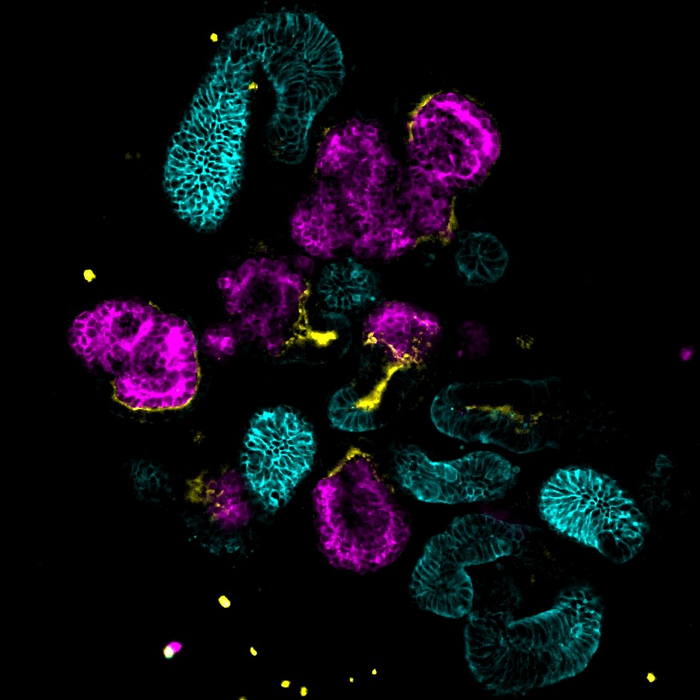Researchers have solved a medical mystery in a poorly understood disease by uncovering which cells cause tumours in patients with tuberous sclerosis complex (TSC). As described in Cell Reports, they did this by creating genetically engineered kidney organoids, or “mini-kidneys” grown from human tissue.

Credit: Cell Research
Researchers have solved a medical mystery in a poorly understood disease by uncovering which cells cause tumours in patients with tuberous sclerosis complex (TSC). As described in Cell Reports, they did this by creating genetically engineered kidney organoids, or “mini-kidneys” grown from human tissue.
“The cells at the origin of tuberous sclerosis tumours have been a mystery for decades,” said senior author Dr. Bill Stanford, senior scientist at The Ottawa Hospital and professor at the University of Ottawa. “Our results can help find possible treatment targets for this challenging disease.”
TSC is a rare genetic disease that causes benign tumours in the skin, brain, kidneys, heart or lungs. TSC tumours are very diverse, arising in children or adults with a range of symptoms from mild to life-threatening and often include seizures and kidney problems. There is no cure and treatment options are limited.
“Kidney disease is the leading cause of death in patients with TSC. Around 60 to 80 percent of patients develop tumours in their kidneys, often reducing kidney function and sometimes leading to catastrophic bleeding,” said lead Dr. Adam Pietrobon, MD-PhD student at The Ottawa Hospital and the University of Ottawa. “There were no adequate lab models to study how TSC affects the kidney, so we made one ourselves.”
TSC is caused by mutations in the TSC1 or TSC2 gene. For most patients, these mutations arise spontaneously during development or early life rather than being inherited from their parents. This makes TSC a difficult disease to study. While lab researchers often use animals to study human diseases, there was no animal model that fully captured TSC’s impact on the kidneys.
TSC tumours in the kidney have puzzled experts because they are extraordinarily diverse in size, cellular makeup and gene expression, even within the same patient. What causes this diversity was unknown, and it makes treatment challenging.
To better understand the impact of TSCs on the kidneys, the team grew 3D kidney tissue in the lab from human stem cells that were genetically engineered to have a TSC1 or TSC2 mutation. Known as organoids, these miniature, simplified versions of kidneys had a genetic profile similar to TSC tumours found in patents. The researchers then took single cells from these kidney organoids and injected them into the kidneys of mice, where they grew into human TSC tumours.
Using these organoids, the researchers revealed that cells called Schwann Cell Precursors are where TSC tumours start in the kidney. They also found this single mutation affects the development of many different kinds of cells, which explains the variation in kidney tumours even within the same person.
“Not only can these ‘mini-kidneys’ help us to better understand this disease, they can also be used to test new therapies,” said Dr. Pietrobon.
Authors: Adam Pietrobon, Julien Yockell-Lelièvre, Trevor A. Flood, William L. Stanford
Core resources: Human Pluripotent Stem Cell Facility, StemCore, Bioinformatics Facility, High Content Imaging Core, Cell Biology and Image Acquisition, Histology/Pathology Core
About The Ottawa Hospital
The Ottawa Hospital is one of Canada’s top learning and research hospitals, where excellent care is inspired by research and driven by compassion. As the third-largest employer in Ottawa, our support staff, researchers, nurses, physicians, and volunteers never stop seeking solutions to the most complex health-care challenges. Our multi-campus hospital, affiliated with the University of Ottawa, attracts some of the most influential scientific minds from around the world. Backed by generous support from the community, we are committed to providing the world-class, compassionate care we would want for our loved ones. www.ohri.ca
About the University of Ottawa
The University of Ottawa is home to over 54,000 students, faculty and staff, who live, work and study in both French and English. Our campus is a crossroads of cultures and ideas, where bold minds come together to inspire game-changing ideas. We are one of Canada’s top 10 research universities—our professors and researchers explore new approaches to today’s challenges. One of a handful of Canadian universities ranked among the top 200 in the world, we attract exceptional thinkers and welcome diverse perspectives from across the globe. www.uottawa.ca
Journal
Cell Reports
DOI
10.1016/j.celrep.2022.111048
Method of Research
Experimental study
Subject of Research
Lab-produced tissue samples
Article Title
Renal organoid modeling of tuberous sclerosis complex reveals lesion features arise from diverse developmental processes
Article Publication Date
5-Jul-2022
COI Statement
Contact Amelia Buchanan ([email protected]) for a full copy of the paper.



